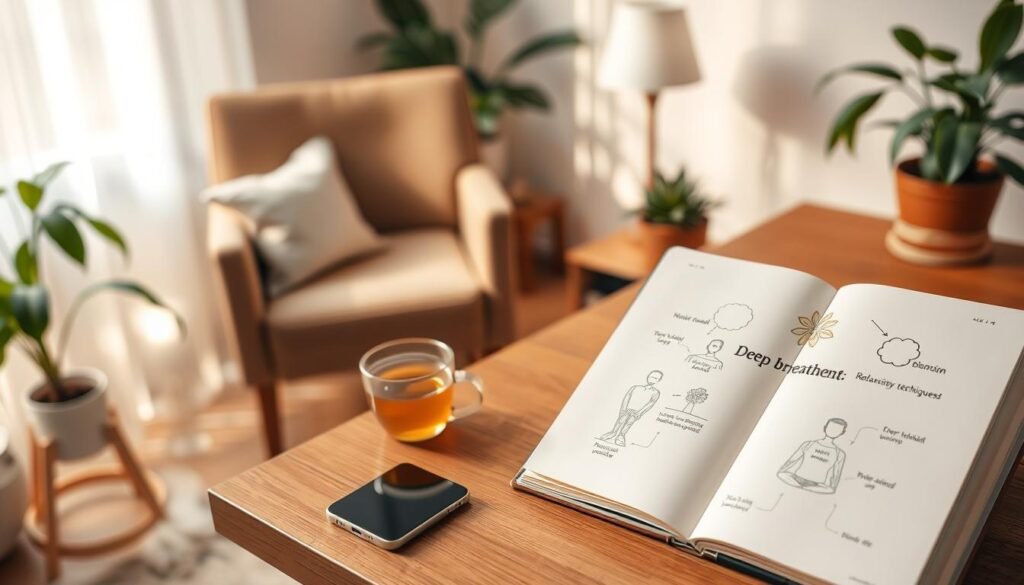Did you know 82% of adults think cell phone use hurts conversations in social settings? This shows how texting anxiety has grown in our modern world. As we communicate more and more through screens, the need to reply right away can make us nervous. This feeling can even make social anxiety worse. People often worry about having to keep in touch all the time. But there are good ways to deal with this problem. You can find out more in the article about texting anxiety and its impact.
Key Takeaways
- Texting anxiety can worsen social interactions and relationships.
- Understanding personal expectations for response times is crucial.
- Digital communication may lead to misinterpretation and misunderstandings.
- Emojis can help convey tone and emotion in messages.
- Therapeutic support is available for managing texting anxiety.
- Taking breaks from screens can alleviate digital communication anxiety.
Understanding Texting Anxiety
Texting anxiety involves feelings of panic or dread related to texts. It’s becoming more common as we rely on digital chats. This anxiety affects many people and can disrupt daily life.
Definition and Symptoms of Texting Anxiety
Texting anxiety can show up as physical and emotional symptoms. You might have sweaty palms, a fast heartbeat, or feel sick. Emotionally, you may fear being misunderstood or worry about saying something wrong. You might also be overly concerned with how others view your messages. All these feelings can indicate texting anxiety.
- Sweaty palms
- A racing heartbeat
- Feeling nauseous
These emotional issues can affect your texting:
- Fear of misinterpretation
- Worry over saying the wrong thing
- Intense concern about how others perceive text messages
When texting, different responses can reveal deep emotional reactions. This adds to texting anxiety.
How Common is Texting Anxiety?
Many people experience texting anxiety. A large number feel unsure about how to respond to texts properly. In research with ages 18-65, quick responses were preferred. Waiting longer than 20 minutes to reply seemed rude to many. This shows the stress in our quick messaging culture.
It’s important to communicate clearly in texts to avoid misunderstandings. These can make anxiety worse. Difficulties in texting can strain relationships. Using emojis and correct punctuation helps share feelings better. This makes texting feel less stressful and more personal.
Causes of Texting Anxiety
Texting anxiety comes from deeper social anxiety and fear of communication. Knowing why it happens is key for those who struggle with chatting online. Texting can make existing fears worse. So, it’s important to understand what’s behind this kind of anxiety.
Social Anxiety and Communication Fears
Texting feels extra hard for people with social anxiety. They worry about how their texts are seen, since there’s no way to show tone or face expressions. This can lead to confusion, making them scared to send a text because they don’t want to be misunderstood.
The Impact of Digital Communication on Anxiety
Digital communication has changed how we connect, affecting our mental health. Many Americans feel they must always check their phones, adding stress. Texting is now a key way to talk, expecting quick replies. This can make anxiety worse, especially if you’re dating and texting a lot.
Social media adds more pressure to stay connected all the time. This can make people even more anxious about digital talking.
| Statistic | Implications |
|---|---|
| 43% of Americans check technology constantly | Perpetuates anxiety related to constant availability |
| 20% connect technology use to significant stress | Indicates a link between digital communication and mental health |
| 262 checks of phones daily | Reflects compulsive behavior impacting mental wellness |
| 73% of users resent social media | Shows a growing discontent with digital platforms |
| 4.2 hours spent on phones daily | Limits the ability to engage genuinely in face-to-face interactions |
To deal with texting anxiety, try setting rules for phone use and talk to people in person. Work on being clear in texts and calls. This helps lower anxiety.
Signs of Text Message Stress
Text message stress shows up in different ways. It hurts both how we feel and our bodies. Knowing the signs helps us understand why we react the way we do. It’s the first step to handle texting stress better.
Physical Symptoms Associated with Texting Anxiety
Facing texting stress, people feel certain physical signs. Some of the common ones are:
- Increased heart rate
- Sweaty palms
- Shallow breathing
- Muscle tension
These signs show our body’s stress during messaging. A study reveals many Americans feel stress tied to their mobile devices. About 20% worry about their smartphone use. Knowing these signs can lead to better habits in messaging.
Emotional Symptoms and Triggers
Texting anxiety also causes strong emotions. Common triggers include:
- Anticipation of a reply
- Interpreting vague messages
- Expectations in communication
These triggers lead to feeling overwhelmed and stressed about texting. Experts in mental health see more anxiety from digital messages. It’s tough to get messages right without seeing faces or hearing tones. Recognizing these triggers can improve how we handle text stress. It makes communication better for everyone.
Texting Anxiety vs. Other Anxiety Disorders
It’s important to know how texting anxiety is different from other anxiety disorders. Texting anxiety is about being worried when we use phones or computers to talk to people. This is not the same as social anxiety disorder, which is about being afraid in social settings.
People can feel the difference between texting anxiety and social anxiety in many situations. Knowing if your texting anxiety is a separate problem or part of other anxiety issues is key. This helps find the best ways to deal with it.
Understanding the Differences
Texting anxiety usually comes from the stress of needing to text back well. It can make you feel unsure about how you talk to others. This stress can grow if you’re not confident in your texting skills.
Studies show that being anxious in social settings can affect how we act online. People might worry a lot about what they write and fear bad reactions. Research with 428 people found those more anxious socially felt worse emotions talking online and offline.
When Texting Anxiety is Triggered by Other Issues
Sometimes, texting anxiety comes from other anxiety problems. It’s important to figure out why you feel this way. How we use texts can show if we’re dealing with social anxiety.
Our emotional reactions to texting might not feel safe if we’re really anxious. Studies suggest that bad texting habits are linked to feeling bad about ourselves and not understanding our emotions well. We need to be aware of how we communicate.
| Feature | Texting Anxiety | Social Anxiety Disorder |
|---|---|---|
| Communication Medium | Primarily through text messages | In-person interactions and social situations |
| Emotional Response | Worry about sending appropriate messages | Fear of being judged in social settings |
| Affected Self-Esteem | May feel dependent on responses | May struggle with overall self-perception |
| Interconnectedness | Can coexist with anxiety disorders | Often linked to multiple anxiety issues |

Strategies to Manage Texting Anxiety
Texting anxiety can really affect people. It’s good to know how to deal with it to feel better and talk easier. Two key ways are using grounding techniques and setting limits on how we text.
Grounding Techniques to Calm Your Nerves
Grounding techniques help control texting stress. They bring us back to now, cutting down panic. Let’s look at some good ones:
- Square Breathing: Breathe in for 4 counts, hold, exhale for 4, then wait for 4. It gets you relaxed.
- Visualization: Think of a calming place. See every part of it clearly to block out stressful thoughts.
- Reframing Your Thoughts: Try seeing your anxiety as excitement. Seeing it differently might make texting less scary.
Setting Boundaries with Digital Communication
Setting limits in our digital chats can lower stress. Expecting fast replies can make us anxious. By trying these tips, we can feel more in control:
- Designate Texting Times: Pick certain times for reviewing texts rather than always looking. It eases the stress of needing to respond right away.
- Communicate Your Availability: Tell people when you can reply. This helps manage their wait.
- Limit Overanalyzing: Remember, everyone has their own reply speed. Trusting in your texting limits can ease worry.
Merging grounding methods with clear texting rules can really help. These actions can improve our relationship with texting, bringing peace of mind.
Practical Tips for Reducing Text Message Anxiety
To manage texting anxiety, make changes to how you communicate. Stop trying to figure out hidden meanings in texts. Instead, focus on talking directly to clear up confusion. Making these small changes can make chatting more enjoyable and less stressful.
Ditching the Decoding Habit
Analyzing texts too much can stress you out. Realize texting doesn’t show body language or tone. Here are tips to reduce texting anxiety from decoding:
- Try to call instead of texting too much.
- When you can, meet up to build a real bond.
- Don’t jump to conclusions from short texts. Ask questions instead.
Clarifying Text Messages to Avoid Misunderstandings
Clear talking can lessen worry over misunderstanding texts. Being clear means no stress for either side. Try these ideas:
- Choose emojis carefully to show your real feelings.
- Reply quickly so others don’t think you’re not interested.
- Keep conversations open by allowing questions for clarity.

Following these tips can improve your texting habits. Mixing digital chats with in-person talks makes friendships deeper and more rewarding. It also lowers the stress of texting by strengthening connections rather than letting technology cause divides.
| Communication Method | Pros | Cons |
|---|---|---|
| Texting | Convenient, quick | Misunderstandings, lacks tonal nuances |
| Phone Call | Immediate feedback, clearer understanding | Can feel intrusive, less convenient |
| In-person Meeting | Full context, body language, deeper connection | Time-consuming, requires coordination |
Communicating Effectively to Combat Texting Anxiety
Effective communication can lower texting anxiety, important in today’s digital world. Choosing face-to-face chats helps a lot. This way, you can share your feelings better using body language. This reduces the chances of getting things wrong. In face-to-face talks, it’s easier to catch the small but key parts of a conversation. These might be missed in texts, leading to stress and worry.
The Importance of Face-to-Face Communication
Meeting people in person creates real connections. It makes you feel less alone, especially if texting stresses you out. A real-life chat lets you share emotions directly. This builds trust in relationships. It also cuts the stress of waiting for texts back. Overthinking messages can make stress worse.
Using Emojis to Convey Tone
When you can’t meet in person, emojis in texts are really useful. They help show how you’re feeling. Emojis fill in for voice tones in written chats. They make it easier to get your emotions across. This lowers the risk of confusion. Understanding a message’s mood can also lessen anxiety. It makes chats clear and helps keep connections strong.
Using these tips, people can support each other through texting anxiety. These strategies focus on real talk and smart texting. They highlight keeping connections strong without misunderstandings.
Learn more about the significance of effective communication in managing anxiety disorders
Practicing Mindfulness to Overcome Texting Anxiety
Mindfulness practices are great for easing texting anxiety. They help people feel better and use their devices in healthier ways. This approach helps us understand ourselves and the here and now. Doing so can make us less anxious about communicating.
Taking Breaks from Your Phone
Stepping away from phones helps us take a breath from constant digital chatter. It clears our minds and helps us focus better. Being mindful makes us notice our surroundings more and enjoy the real world.
Taking a little time off from gadgets can create a balanced tech life. It’s good for our mental health.
Staying Present in Daily Life
Being mindful each day helps us connect more deeply and worry less about texting. Techniques like deep breathing help us stay in the present. These methods calm us and make everyday interactions more meaningful.
By practicing mindfulness, we focus more on real interactions than on anxious thoughts. This makes our experiences richer and more rewarding.

| Mindfulness Techniques | Benefits |
|---|---|
| Deep Breathing | Reduces anxiety by slowing the heart rate. |
| Progressive Muscle Relaxation | Release tension and lower anxiety. |
| Visualization | Enhances performance and retention of information. |
| Positive Affirmations | Boosts self-confidence and reduces feelings of anxiety. |
| Engaging Senses Outdoors | Promotes mindfulness and connection with nature. |
Seeking Professional Help for Texting Anxiety
Feeling overwhelmed by texting anxiety is common. Knowing when to get therapy is key, especially if this anxiety is constant. If it stops you from doing daily tasks, working, or hanging out with friends, getting professional help is smart. Licensed therapists provide personalized plans to help. They teach coping skills to make technology and chatting less stressful.
When to Consider Therapy
It’s time to think about therapy if:
- Long-lasting anxiety affects everyday life.
- You keep checking messages all the time.
- You use substances to feel better, showing you need new ways to cope.
Seek help when texting stress makes you uneasy and lowers your quality of life. This stress often comes from different anxiety issues that experts can help manage.
Exploring Treatment Options
Treating anxiety means you can get better at communicating. Cognitive Behavioral Therapy (CBT) changes negative thoughts, while mindfulness helps stay in the now. Facing fears little by little works too, and so does learning coping techniques from Dialectical Behavior Therapy (DBT).
Support groups and online sites offer community and support for those with similar struggles. Looking into these treatment options can bring new ways to beat texting anxiety.
Conclusion
Today, it’s key to tackle texting anxiety to foster healthier relationships. The COVID-19 lockdowns have made texting a main way we connect. This form of communication is convenient but can also cause anxiety due to misunderstandings.
To cope with this anxiety, it’s crucial to be aware of what we text. Tools like Leora Trub’s app help manage these fears. Moe Ari Brown, a therapist, can also identify the root causes of this anxiety. This makes our text conversations clearer and less stressful.
Encouraging curiosity and kindness in our messages helps us understand others better. This not only makes us more confident in texting but also improves how we relate to each other. Especially in romantic relationships, this approach can lead to stronger connections.
Overcoming digital communication anxiety means recognizing harmful patterns, like texting too much. Creating healthy texting habits is important. Open talks about our feelings can make a big difference. As digital communication remains essential, prioritizing these practices is crucial for our happiness and relationships. For more help with communication fears, consider checking out resources on overcoming cognitive distortions and relationship anxiety.